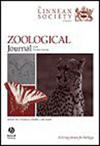对Niphargidae(甲壳纲:片足纲)起源和系统发育的新认识,包括一新种的描述和Niphargellus属与Niphargus的同义化
IF 2.8
2区 生物学
Q1 ZOOLOGY
引用次数: 0
摘要
聂氏片脚类动物科(Niphargidae)地下片脚类动物引人入胜的起源和分布,尤其是在欧洲西北部和不列颠群岛的分布,受到了更新世冰川的严重影响,冰川掩盖了大部分远古事件。在布列塔尼发现的一个新物种(此处描述为 Niphargus quimperensis sp.nov.)与英伦三岛的两个微小特有物种(一个被归入 Niphargus 属,另一个被归入 Niphargellus 属)关系密切,再加上在欧洲进一步采集的 Niphargellus 标本,使得我们能够构建一个全面的分子系统发育和新的 Niphargidae 科时间校准树。新发现的 Niphargus quimperensis sp.此外,系统发育分析表明,Niphargellus属是多单系的,必须作为Niphargus的小异名处理。最后,我们提出,Niphargus 的海洋祖先对大陆淡水的殖民可能发生在晚白垩世北大西洋开辟时期的欧洲西北部,而 Niphargus quimperensis sp.本文章由计算机程序翻译,如有差异,请以英文原文为准。
New insights into the origin and phylogeny of Niphargidae (Crustacea: Amphipoda), with description of a new species and synonymization of the genus Niphargellus with Niphargus
The intriguing origin and distribution of subterranean amphipods of the family Niphargidae, particularly in north-western Europe and the British Isles, were heavily influenced by Pleistocene glaciations, which obscured most ancient events. The discovery of a new species in Brittany (described herein as Niphargus quimperensis sp. nov.) that is closely related to two tiny endemic species of the British Isles (one ascribed to the genus Niphargus and the other to Niphargellus), along with further collection of specimens of Niphargellus in Europe, allowed the construction of a comprehensive molecular phylogeny and a new time-calibrated tree of the family Niphargidae. The discovery of Niphargus quimperensis sp. nov. confirmed the position of its clade as sister to all other niphargids. Moreover, phylogenetic analysis demonstrate that the genus Niphargellus is polyphyletic and must be treated as a junior synonym of Niphargus. Finally, we propose that the colonization of continental freshwater by the marine ancestors of Niphargus may have occurred in north-western Europe during the opening of the North Atlantic in the Late Cretaceous, whereas the split of Niphargus quimperensis sp. nov. from the other representatives of its clade may have been related to the isolation of Brittany from the British Isles in the Early Miocene.
求助全文
通过发布文献求助,成功后即可免费获取论文全文。
去求助
来源期刊
CiteScore
6.50
自引率
10.70%
发文量
116
审稿时长
6-12 weeks
期刊介绍:
The Zoological Journal of the Linnean Society publishes papers on systematic and evolutionary zoology and comparative, functional and other studies where relevant to these areas. Studies of extinct as well as living animals are included. Reviews are also published; these may be invited by the Editorial Board, but uninvited reviews may also be considered. The Zoological Journal also has a wide circulation amongst zoologists and although narrowly specialized papers are not excluded, potential authors should bear that readership in mind.

 求助内容:
求助内容: 应助结果提醒方式:
应助结果提醒方式:


